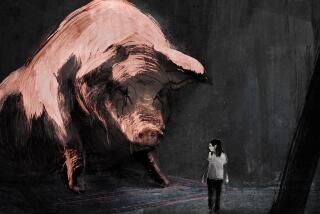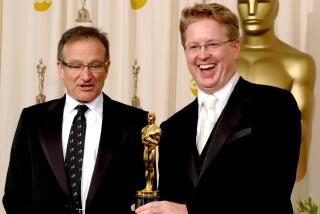Dazzling Gem of Animation Rediscovered
- Share via
Milestone Film & Video’s release of “The Adventures of Prince Achmed” will be a revelation to animation buffs. This dazzling and visually breathtaking 1926 fantasy predates Disney’s “Snow White and the Seven Dwarfs” by 11 years and stakes a claim to being the first animated feature.
More important, it rescues from obscurity the name of pioneering female animator Lotte Reiniger, about whom Jean Renoir said, “She was born with magic hands.”
Three years in the making, “Prince Achmed” is an Arabian Nights fantasy brought to life with silhouette figures and played against fantastic color-tinted backgrounds. This 72-minute cinematic shadow play--silent save for a musical score by Wolfgang Zeller--follows the adventures of the prince, who is “young, brave and eager for adventure.”
He finds excitement aplenty when he unwittingly mounts an evil sorcerer’s flying horse and vanishes into the clouds. His travels take him to the spirit land of Wak Wak, where he falls in love with Princess Peri Banu. Standing between them and happiness are the Sorcerer, who covets Achmed’s sister, a Chinese emperor, a hunchback slave and assorted demons and ogres. Coming to Achmed’s aid is a volcano sorceress and Aladdin, who, too, loves Achmed’s sister.
The German-born Reiniger, who died in 1981 at age 82, was the very model of an independent filmmaker. She worked with a small but distinguished crew that included her husband, Carl Koch, who worked with Renoir on his masterworks “Rules of the Game” and “The Grand Illusion”; Walter Ruttmann, director of the expressionist classic “Berlin: Symphony of a City”; and Berthold Bartosch, an avant-garde animator best known for his 1932 short “The Idea.”
But she meticulously cut all the silhouette figures herself and meticulously manipulated them frame by frame for the camera (the film comprises about 300,000 camera shots).
“There were not women doing animation [at that time],” observed film historian and teacher Cecile Starr, co-author of the book “Experimental Animation.” “She was a very talented, very daring, very determined young woman who started her film career when she was 18 years old and finished it when she was 78 or 79.”
Reiniger described her method in the cinema journal Sight and Sound in 1936, a few years after “Prince Achmed” had played in the United States. The silhouette marionettes, she wrote, were cut out of black cardboard and thin lead. Each limb was cut separately and joined with wire hinges. As with cartoon drawings, the figures were photographed “movement by movement.”
One of the marvels of “Prince Achmed” is how, despite the limitations of the medium, Reiniger was able to imbue her characters with distinct personalities.
“It’s all in the way they move,” noted animator and “Walt Disney’s Nine Old Men” author John Canemaker. (Milestone is also releasing a compilation of his classic short films, “John Canemaker: Marching to a Different Toon.”) “That’s always been the signifier of great character animation that defines itself by the way it moves, not by the way it sounds. If a silhouetted character’s pose conveys the meaning of the action or the mood, that is considered a great animation pose. Here’s Lotte Reiniger, whose film is completely silhouetted and has to depend on the power and the timing of her ‘acting,’ and it’s just great.”
Another of “Prince Achmed’s” innovations is the use of a multi-plane camera that Koch designed, which again anticipates Disney and adds dimension to the image.
Will the new attention for “Prince Achmed” rewrite animation history?
“‘Snow White’ could be called the first feature-length animated cartoon. That would be legit,” Canemaker said. “There are other films that go back to the silent era that were lengthy as well. Max Fleischer did a film on the theory of relativity. There is some controversy about a film that was made in Argentina that was also rather lengthy. But for many [animation scholars], ‘Prince Achmed’ is [considered] the first animated feature.”
The film’s home-video release “only revises animation history to those people who are willing to revise,” Starr said. “Columbus discovered America, and it doesn’t matter that there were people who came before. That’s the way the story goes and that’s the popular version, and it’s going to be very hard to shake it. Disney will always be first to those who are going to believe the Disney version, no matter what evidence is presented to the contrary.”
“Prince Achmed” is no antiquity. It is a film that astonishes.
“Oh, sure,” Canemaker agreed. “Just the artistry of it, the look and the design. It’s fairy tales, fantasy, escapism and romance. It’s the Arabian Nights. It’s monsters and dragons and princes and princesses. And because it is a silent film with music, it has universal appeal.”
“It’s a wonderful rediscovery, it really is,” he continued. “And to have this so accessible now to new audiences is great, because the great thing about animation is that it is opening up. It isn’t all just one style or one type of storytelling. The expansion of even the definition of animation has really changed. To show there’s another way of doing these techniques is exciting and mind-opening.”
Film historian Starr has shown “Prince Achmed” to her students at Bennington College in Vermont. Their reaction? “They’re terribly impressed with her [Reiniger’s] career,” she said. “When [they discover it was made in] 1926, they are definitely overwhelmed by it and by the idea that a woman made it.
“Reiniger herself did not feel disadvantaged in being a woman. What she did feel was a kind of resentment that the kind of films she wanted to make were so seldom financed by people who were turning out--to her--highly forgettable animation.”
*
“The Adventures of Prince Achmed” and “John Canemaker: Marching to a Different Toon” each retail for $29.95 (VHS only). To order, call (800) 603-1104.
More to Read
Only good movies
Get the Indie Focus newsletter, Mark Olsen's weekly guide to the world of cinema.
You may occasionally receive promotional content from the Los Angeles Times.









